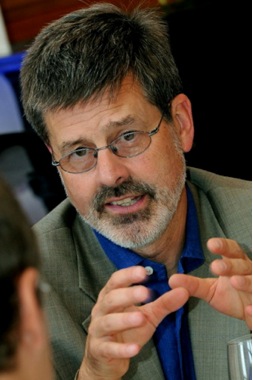 The Director of the Center for Oil Shale Technology and Research (COSTAR) talks to Green Prophet about the benefits and detriments of oil shale exploration.
The Director of the Center for Oil Shale Technology and Research (COSTAR) talks to Green Prophet about the benefits and detriments of oil shale exploration.
When we first submitted our open letter to David de Rothschild, in which we asked him to intervene in an oil-shale development project in the Elah Valley now backed by Lord Jacob Rothschild and Rupert Murdoch, Jeremy Boak wrote in to question the science of our oil shale assertions. David responded, pledging to look into the matter.
In the meantime, we have asked Jeremy, the director of the Center for Oil Shale Technology and Research (COSTAR) funded by ExxonMobil, Shell, and Total, to discuss the technology that Israel Energy Initiatives (IEI) would use to extract energy from oil shale, as well as to shed light on the different regulatory environments facing developers in the United States and Israel. Here are his answers:
1) Jeremy: can you tell us about your experience with oil shale research and development?
For the past five years, I have chaired the Oil Shale Symposium here in Golden. This revived previous series of Symposia from 1964-1992 and 1918-1924(?). Our recent symposia have drawn about 300 people each year from about 20 countries… We have supported international participants, including students from Estonia, New Zealand, Turkey, and Jordan. The Symposium has been sponsored by a wide range of companies, including international oil companies, service companies, and technology providers.
In addition, I have been the director of the Center for Oil Shale Technology and Research (COSTAR) for the past three years. We conduct research on the geologic and geophysical properties of oil shale, mainly in the U. S., and have been working to create a globally accessible database of oil shale documents with a geographic information system interface. Our sponsors include three major oil companies (ExxonMobil, Shell and Total).
Our view of the reason for support for these activities is that we can provide independent information on the development of oil shale. One of the results of my research on CO2 and water use issues is that the really critical information required to provide reasonable provisional answers is limited in scope, and therefore might be made available without compromising proprietary concerns. However, I can see that the misrepresentation of what information is available is a serious barrier to release of more.
2) Israel Energy Initiatives (IEI) was granted a license by Israel’s Ministry of Infrastructure to exploit Israel’s oil shale reserve with a technology called in-situ. Can you say more about how this works?
In situ technology involves transferring heat into oil shale at depth, to raise the temperature to the levels where the solid hydrocarbons begin to break down into compounds that are liquid or solid at room temperature. Shell, ExxonMobil, Total and other companies have developed a wide variety of approaches to doing the heating, and these are the techniques that current Research, Development and Deployment (RD&D) leases in the U. S. are testing. Electric heaters or gas burners have been proposed, as has injection of hot fluids from the surface.
3) Has in-situ technology been used on a commercial scale before?
In situ technology has been used to produce small quantities of oil from the Green River Formation during Shell’s previous tests. Shell has also used its In situ Conversion Process (ICP) to produce 140,000 barrels of high quality crude oil from heavy oil sands in Alberta. However, neither of these would be considered commercial production. They do provide substantial indication that further testing is warranted on a variety of resources.
4) Along with Shell and Chevron, American Shale Oil LLC was granted a ten year lease by Colorado’s Bureau of Land Management to prove its in-situ technology and its environmental impact. Only when the technology is proven to be satisfactory will AMSO be granted a commercial lease. AMSO is also on the advisory board for Genie Oil & Gas Inc., which owns 89% of IEI. IEI’s license allows for testing in- situ technology in the Elah Valley without having to submit any kind of environmental impact assessment, much less ten years worth of rigorous testing. What do you think about this?
I am not familiar with the leasing process in Israel. Granting of a lease for testing (which you indicate is what this license is for) would not appear to be the same as granting a lease for commercial production. In this country, an environmental assessment is required for granting such an RD&D lease.
However, companies have been frustrated that, even after that is complete, they must address the concerns of 47 different regulatory and permitting agencies before they can proceed to put any project on the ground. This does not seem to me to be the most productive way to evaluate technology that is only allowed to occur on 160 acres until commercial feasibility has been demonstrated (and additional land has been paid for at Fair Market Value).
These agencies have commonly been rigid about meeting their particular requirements, even when these are overlapping, leading to exceeding paperwork burdens. I would want to hear what the government says about its approach to environmental assessment and mitigation before I made a judgment.
Given what I know about the company doing this work, it is unlikely that they will be able to fund commercial development without conducting extensive testing of their technology, including demonstrating environmental compatibility.
5) On Sunday, Israel’s cabinet approved a NIS 2.2 billion (US$ 0.6 billion) plan to reduce greenhouse gas emissions. How would a national oil shale program on the scale proposed by IEI/Genie Oil & Gas Inc. (300 billion barrels) impact Israel’s GHG emissions?
That would depend on both the government’s strategy for reduction of greenhouse gas emissions and on the technology proposed by IEI. AMSO has been a leader in evaluating means to mitigate the impact of oil shale production on greenhouse gas emissions, in the person of Alan Burnham, the AMSO representative on the Genie board. So I would expect that the Israeli project would respond actively to any mandate from the government on greenhouse gas emissions.
If Israel envisions weaning itself from hydrocarbon fuels as part of its strategy, oil shale might be problematic. If, on the other hand, Israel recognizes the transition away from these carbon-based fuels as a longer term goal, it may join many other countries in investigating carbon capture and sequestration as a means to mitigate carbon emissions until carbon-free systems can become economic. In the grand scheme of energy consumption, the world is likely to need to address carbon emissions on a large scale long before oil shale becomes a major contributor to emissions.
6) Rupert Murdoch claims that unlocking Israel’s oil shale (ie. testing the technology in Israel so that it can then be proven in the United States, which has a much greater reserve?) will completely shift the oil/energy paradigm. Can you comment on this?
The resources are large enough to do so. An important question remains how soon the industry can grow to a level important on the global scale. I raise this question for all alternative energy sources. Growth of an energy source to the level of one million barrels per day of energy equivalent has generally taken decades. I don’t see any of the renewable achieving this level any faster either.
In one of your articles, you cite Jack Dyni’s USGS assessment of oil shale as showing limited and mediocre resources in Israel. The oil shale Resource IEI talked about at the recent Oil Shale Symposium was not identified in Jack’s assessment. So the numbers are not in conflict.
One of the unfortunate problems with a lot of reports on oil shale these days is that they are out of date. Environmental groups especially, but other political constituencies as well, are willing to weigh in on oil shale without doing their homework. The oil shale in Israel and Jordan is of medium grade – not as rich as the richest Green River Formation oil shale. This will be some challenge to produce economically, but without the data IEI will gather in its testing, no one can determine whether this is a fatal flaw.
7) You have a lot more experience with oil shale than I do. Am I leaving anything out that you would like to clarify?
To me, all energy resources have their challenges. Wind power currently depends upon high strength magnets made with neodymium, a metal that must be mined and occurs in minerals that also concentrate uranium, and that is currently monopolized by the Chinese. It seems to me important to point out the important environmental challenges to development of oil shale or any of these new energy resources. But I think these resources deserve the opportunity to be tested, and to have the chance to show whether they can be developed in compliance with environmental standards and economically.
I do not support those (on either side of the debate) who wish to shut down technology development before such testing has been done. Because I have worked under strong environmental regulations, I see lots of room for more effective risk reduction with streamlined regulation, but I don’t wish to see environmental considerations ignored.
8) What are the environmental impacts of oil shale exploration?
a) Potential CO2 release from power generation or downhole combustion to heat rock. IEI will presumably use the AMSO technique, which involves downhole burners operating on natural gas. This may be one of the most efficient approaches to in situ heating, and does allow for carbon capture of the exhaust gases. A small additional amount of CO2 (5-15% of the total) may come from reactions of the kerogen and the minerals in the rock.
b) Water use for the process. One major use of water for in situ production would be for steam condensation in a power plant. Because IE will not heat downhole with electricity, this use may be excluded. A second use is for reclamation of the underground, to “steam clean” the rock of any organic contaminants not recovered during production, to protect groundwater.
c) Socioeconomic impact. Federal governments collect large royalties on hydrocarbon production. The local impacts occur immediately, but the filtering down of the Federal dollars to states and localities is substantially delayed, and portions are diverted to other needs. On the other hand, at least in western Colorado, rapid development and population not related to hydrocarbon production is not generating royalty revenue, but is having impacts. So a systematic view is important to resolve a broader impact.
d) Surface disturbance. An in situ production block will be largely cleared of vegetation during the life of the production, although well-recognized reclamation approaches can readily restore the land once production and any in situ reclamation is complete. The surface disturbance question comes down to how much surface needs to be disturbed at any one time. For Colorado, this can be relatively moderate due to the richness of the oil shale.
IEI clearly indicates that it expects its demonstration to indicate “that the production does not hurt the environment,” and that commercial testing will require additional approvals. Because the operations are best done compactly (at least with respect to traditional oilfield operations) the ability to avoid affecting environmentally sensitive areas and pathways may actually be better for in situ operations than for other hydrocarbon production.
e) Air emissions. These will be similar to existing sources, and should require little modification to regulatory frameworks, although relevant review is potentially worthwhile.
Image via Jeremy Boak
More on Israel’s oil shale exploration:
NGO Takes IEI/Genie Oil Shale Plan To Israel’s High Court







Comments are closed.